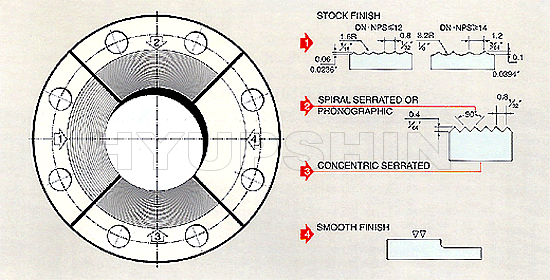ZheJiang Chengjiu Pipeline Co., Ltd.
Tel: 0086-0570-5012312
Fax: 0086-0570-5012312
E-mail: sales@cheng-jiu.cn
Flange Facing Type & Finish
- Home
- >
- Flange Size
- >
- Types
- >
- Flange Facing Type &...
| ||||||||||||||||||||||||||||||||||||||||||||||||||||||||||||||||||
Flange Facing: The finish of contact faces of pipe flanges and connecting end flanges of fittings shall be judges by visual comparison with Rastandards (See ANSI, ASME B46.1) and not by instruments having stylus tracers and electronic amplification, the finishes required are given below. Other finishes maybe furnished by agreement between user and manufacturer. Raised Face and Lare Male and Female: Either a serrated concentric or serrated spiral finish having from 24 grooves/in. to 40 grooves/in. shall be used. The cutting tool employed shall have a 125 μin. roughness. 
| ||||||||||||||||||||||||||||||||||||||||||||||||||||||||||||||||||
Flange Facing Types
|
| |
|
| |
|
| |
|
| |
|
| |
|
| |
|
|
ZheJiang Chengjiu Pipeline Co., Ltd.
Tel: 0086-0570-5012312
Fax: 0086-0570-5012312
E-mail: sales@cheng-jiu.cn
Flange Facing Type & Finish
- Home
- >
- Flange Size
- >
- Types
- >
- Flange Facing Type &...
| ||||||||||||||||||||||||||||||||||||||||||||||||||||||||||||||||||
Flange Facing: The finish of contact faces of pipe flanges and connecting end flanges of fittings shall be judges by visual comparison with Rastandards (See ANSI, ASME B46.1) and not by instruments having stylus tracers and electronic amplification, the finishes required are given below. Other finishes maybe furnished by agreement between user and manufacturer. Raised Face and Lare Male and Female: Either a serrated concentric or serrated spiral finish having from 24 grooves/in. to 40 grooves/in. shall be used. The cutting tool employed shall have a 125 μin. roughness. 
| ||||||||||||||||||||||||||||||||||||||||||||||||||||||||||||||||||
Flange Facing Types
|
| |
|
| |
|
| |
|
| |
|
| |
|
| |
|
|






